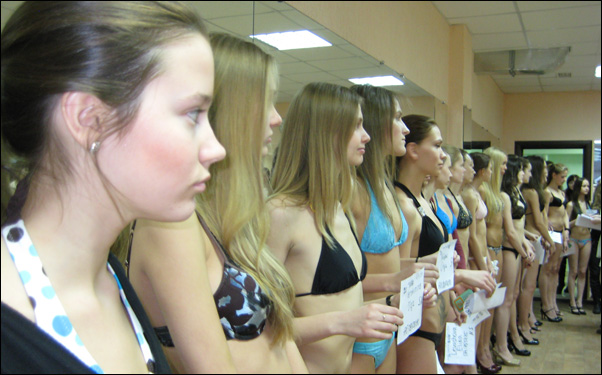For a film in which nothing’s come easily, “Girl Model” started with a simple e-mail. Ashley Arbaugh, a former model-turned-talent-scout had seen a double feature of Ashley Sabin and David Redmon’s documentaries “Intimidad” and “Kamp Katrina” at MoMA and contacted the documentarian duo to see if they’d be interested in making a film about her profession.
“You could say she scouted us,” says Sabin, who is currently on the hunt herself to find backing for an audience engagement campaign to accompany the theatrical release of the resulting film on Kickstarter, a campaign that since we spoke to the filmmaker has successfully reached its goal, but would surely benefit from further contributions. As our review back from its premiere at SXSW in March would suggest, it deserves as wide a release as possible given the “unpleasant underground Sabin and Redmon expose” when it follows a slender 13-year-old named Nadya from humble origins in Siberia to the cutthroat environment of Japan, where she is promised a modeling contract that will help her extended family back home.
Soon enough, Nadya finds that she has little faculty once she travels to Tokyo with clearly no one looking out for her, including Arbaugh, the scout who plucked her out of a parade of aspirants in Russia and then moves onto her next job. As a result, Sabin and Redmon were faced with the challenge of balancing their objectivity with their desire to help an underage girl in need, something that Sabin now says required “a constant figuring out within the situation.”
“With Nadya being so young, we really didn’t want to exasperate her situation any more than it needed to be, but at the same time, we wanted to document her experiences and her isolation and her depression,” says Sabin, who recalls arriving with the 13-year-old at the airport in Japan with no one there to pick her up. “Do we film her for six hours trying to figure out how to get to the agency, then she gets totally flustered and maybe in the end distrusts us or do we bring her to the agency? We decided in the end to bring her to the agency.”
That was only one of several ethical dilemmas Sabin and Redmon had to deal with while making “Girl Model,” not the least of which was what was unfolding in front of their cameras. Through the time spent with Nadya and Arbaugh on separate ends of the earth, the filmmakers depict a process not far removed from human trafficking where young women from impoverished conditions are often taken advantage of, whether as in Nadya’s case, the promise of regular work is hardly as advertised and made worse in a foreign culture, or that the same networks that serve to provide models work may also funnel some into prostitution. According to Sabin, it was the latter that was the driving force behind Arbaugh’s involvement, which proved problematic since the filmmakers intended to be objective observers, even if it meant clashing with the person who led them to investigate in the first place.
“We had no interest in telling a story that was an exposé, something that was going after the industry, so we weren’t as interested in setting up a story which would follow girls into prostitution for ethical reasons,” says Sabin. “There’s a lot of lessons that come out of the making of the film and I think one of them for us is that if someone approaches you to make a story about themselves, run the opposite way.”
Still, the lesson Sabin would like all audiences to take away from “Girl Model” is the idea that people take more time to consider what’s behind the images they consume on a regular basis while standing next to a magazine rack in line at the supermarket or on the billboards around them. And they’re not alone. Rachel Blais, one of the models who provided an interview for the film has since gone on to become a proselytizer of sorts for the documentary, attending many screenings and even setting them up, hoping to open up people’s eyes to the widespread use of underage models and hopefully encourage legislation to change exploitive practices in the fashion industry. For that reason, the Kickstarter campaign for the film isn’t only offering rewards that benefit a contributor personally, but also ones that will benefit communities since they’ll provide DVDs for educational use at libraries. Additionally, further contributions will help make the film more accessible to others in foreign countries since the filmmakers hope to make “Girl Model” available with subtitles.
However, what’s most exciting about “Girl Model” may be in fact what’s most exciting to the filmmakers themselves in how they continue to refine a largely unadorned verite style to tell stories of global importance through a distinctly human lens, addressing large scale issues with intimacy.
“That’s the direction we’re going even more,” says Sabin, who with Redmon, has already completed another film “Downeast,” about a lobster processing plant in New England that hopes to bring back work to America instead of outsourcing it, that premiered recently at Tribeca. “I don’t know what it is about that style that attracts us, but for me personally, when you construct a story that has breathing room and allows people to feel like they were there or have the emotional impact that they were there, it’s more profound of an experience.”
“Girl Model” opens at the IFC Center in New York on September 5th and will play around the country. A current list of theaters can be seen here, but to help with its release, back its Kickstarter campaign here.




